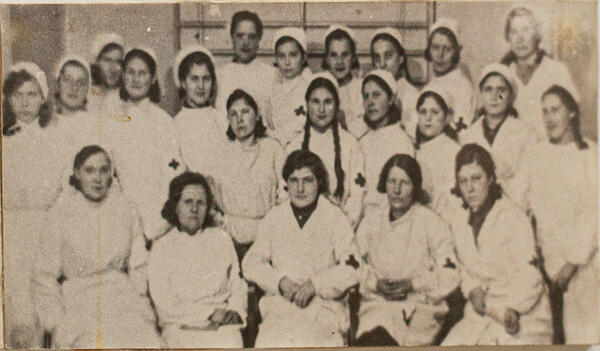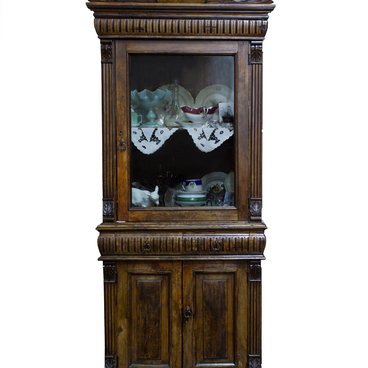In the early period of the Great Patriotic War, the Tambov Oblast became one of the largest hospital bases in the Soviet Union. During the war, two military hospitals were located in Kotovsk: hospital No. 1980 in the Palace of Culture and hospital No. 1393 in School No. 1. This photograph from the museum’s collection shows the medical staff of evacuation hospital No. 1393.
Hospital No. 1393 was first established in Tambov back in 1940. Initially, the building of Tambov School No. 7 on Internatsionalnaya Street, 4 was allocated for the hospital. However, due to its technical specifications, the building could not become a fully equipped hospital. That is why in April 1941, the evacuation hospital was moved to Kotovsk where it was placed in the building of school No. 1.
In order to equip the hospital, the school building in Kotovsk was fully renovated: new doorways were made, partitions were installed to separate future wards and doctor offices from each other, hot and cold water supply, and a sewage system were established.
Kotovsk citizens actively participated in preparing the evacuation hospital. All the necessary materials were manufactured at Plant No. 204 (now known as the Tambov Gunpowder Factory). Kotovsk women helped to keep the hospital in order by washing the windows and floors and decorating the rooms with flowers.
Wounded from the front were brought to the hospital since the early days of the war. On December 12, 1941, the first soldiers who had suffered severe hypothermia were evacuated to the hospital from the battlefield. In order to help them, it was necessary to connect electric wires and the necessary equipment to their beds within a very short period. Citizens helped to gather the necessary wire, which was used to make 80 bed frames.
The medical brigade, which consisted of female workers of Plant No. 204, was doing an enormous amount of work, especially on the days of the arrival and departure of patients. At night, they took turns to watch by the bedside of the sick, and in the morning, they went to work at the factory. Women tried their best to raise the morale of soldiers and sometimes gave them handkerchiefs, cigarette cases, and other souvenirs.
Besides, all the hospital wards were assigned their own patrons — the members of various organizations and enterprises, including the City Executive Committee, the City Committee of the All-Union Communist Party, the bakery, the trade school, the forestry enterprise, the police, the Palace of Culture, and many others.
Hospital No. 1393 was first established in Tambov back in 1940. Initially, the building of Tambov School No. 7 on Internatsionalnaya Street, 4 was allocated for the hospital. However, due to its technical specifications, the building could not become a fully equipped hospital. That is why in April 1941, the evacuation hospital was moved to Kotovsk where it was placed in the building of school No. 1.
In order to equip the hospital, the school building in Kotovsk was fully renovated: new doorways were made, partitions were installed to separate future wards and doctor offices from each other, hot and cold water supply, and a sewage system were established.
Kotovsk citizens actively participated in preparing the evacuation hospital. All the necessary materials were manufactured at Plant No. 204 (now known as the Tambov Gunpowder Factory). Kotovsk women helped to keep the hospital in order by washing the windows and floors and decorating the rooms with flowers.
Wounded from the front were brought to the hospital since the early days of the war. On December 12, 1941, the first soldiers who had suffered severe hypothermia were evacuated to the hospital from the battlefield. In order to help them, it was necessary to connect electric wires and the necessary equipment to their beds within a very short period. Citizens helped to gather the necessary wire, which was used to make 80 bed frames.
The medical brigade, which consisted of female workers of Plant No. 204, was doing an enormous amount of work, especially on the days of the arrival and departure of patients. At night, they took turns to watch by the bedside of the sick, and in the morning, they went to work at the factory. Women tried their best to raise the morale of soldiers and sometimes gave them handkerchiefs, cigarette cases, and other souvenirs.
Besides, all the hospital wards were assigned their own patrons — the members of various organizations and enterprises, including the City Executive Committee, the City Committee of the All-Union Communist Party, the bakery, the trade school, the forestry enterprise, the police, the Palace of Culture, and many others.
They bought bedding, dishes, napkins and tablecloths, lamps, curtains, carpets and sofa covers, writing paper, board games such as dominoes and chess, and books for the wounded. The Bokino and Serebryaki village soviets also helped the hospital: once a month the collective farmers visited the hospital, bringing milk, meat, and other products.
Between 1941 and 1942, 1,868 wounded and sick were admitted to hospital No. 1393. All but four of them survived.
Between 1941 and 1942, 1,868 wounded and sick were admitted to hospital No. 1393. All but four of them survived.



